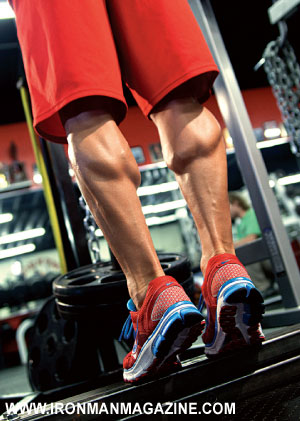 Q: Is there a special calf routine that can work even when others haven’t?
Q: Is there a special calf routine that can work even when others haven’t?
A: Before I get to a special routine, there’s important background material to cover. Here are four of the main explanations for poor calf development:
1) Neglect. Train your calves as seriously as you do your biceps but without overtraining them, and your calves should improve, genetics permitting.
2) Poor genetic potential. Some people have high calves—long tendons at the bottom and only a short length of meaty muscle at the top. If you’ve inherited such calves, your potential will be less than typical.
3) Ineffective training. Some bodybuilders grossly overtrain their calves, which inhibits, if not prohibits, growth. And some, whether they overtrain their calves, place too much attention on the seated calf raise, which primarily works the soleus, not the more substantial gastrocnemius. Standing calf raises with the knees locked or just slightly unlocked work the soleus and the gastrocnemius.
4) Insufficient overall growth. Some bodybuilders don’t have a particular calf deficiency but have an overall deficiency of muscle. Generally, it’s not possible for natural bodybuilders to produce substantial growth in one bodypart in isolation from the rest of the physique. So to make it easier to build bigger calves, build an overall bigger physique.
The special routine: In the 1970s Peary Rader’s Iron Man published a calf routine that Peary thought highly of—he published it more than once. I tried it and gained from it. Here’s a summary of the routine, developed by Jim McLellan. He claimed to have gained 1 1/2 inches after using it for two months, and he reported three men who each gained two inches after three months on it.
You must use a standing calf machine, one with a high enough block that you can’t touch your heels to the floor at the bottom of each rep. Keep your knees straight or just slightly unlocked.
Following a light warmup set, select a weight with which you can just squeeze out 15 reps of two-legged calf raises. Do full-range-of-motion reps, in a deliberate, smooth manner. Hold at the top, fully contracted position of each rep for a second. Don’t rush the reps.
Immediately after completing the 15th rep—and while staying in position in the calf machine (but set the weight down)—take your left foot off, raise it a little, and shake it twice so that the calf muscle flops around each time. Then put your left leg back on the block, take your right foot off and shake it. McLellan urged not taking more than eight seconds each time you shake a leg. After shaking both legs, perform eight reps of the two-legged calf raise, then do the shaking again, then another eight reps, then a further bout of shaking and another eight. (You may not get all eight reps on each of the three sets, but do the best you can and aim to build up to three sets of eight as the weeks go by.) Immediately after the third batch of eight reps, and without any more shakes, do “burns.”
Burns are short, quick but controlled bounces over the bottom three or four inches. Do them until your calves scream so much that you have to stop. Even then you’re still not done. Immediately go into the top, fully contracted position on two legs, then on your left foot only slowly lower yourself all the way down. Go up on two feet, and slowly lower using only your right foot. Then up on two, down on your left, and so on, continuing to alternate legs for 10 to 20 reps, depending on how much you can stand. The discomfort will be severe.
All of the above, starting with the initial 15 reps and finishing with the alternating one-leg work, is one set. Take no more than five minutes’ rest after the first set, and perform a second one. McLellan recommended massaging and shaking the calves during the rest period.
The above is to be done for two weeks. Then you further intensify the routine for an additional six to 10 weeks. Following the two-feet-up/one-foot-down reps, immediately do another bout of the short-range burns followed immediately by a further bout of the two-feet-up/one-foot-down reps. So each “set” is extended even further—but you still do two of them. McLellan believed that performing the two-feet-up/one-foot-down reps immediately after the burns was the key to the routine.
As your tolerance of discomfort improves, increase the number of burns and the number of two-feet-up/one-foot-down reps. If you can also add a little weight to the 15-rep set that starts everything off, so much the better, but keep your exercise technique perfect—smooth, controlled reps.
The original article didn’t specify training frequency. I suggest twice a week at most or three times every two weeks—Monday, Friday, Wednesday, Monday, etc.
McLellan advised resting the calves after three months at the most on the routine. He didn’t specify for how long. After that he advised doing the specialization routine for a second phase. My suggestion: If the first phase gave you at least half an inch, perform two or three regular work sets of 20-plus reps of calf raises twice a week for three months, then return to the exact same specialization routine for a second dose of no more than three months. If the first time around didn’t give you at least half an inch, modify the routine—train it three times every two weeks.
—Stuart McRobert
www.Hardgainer.com
Editor’s note: Stuart McRobert’s first byline in IRON MAN appeared in 1981. He’s the author of the new 638-page opus on bodybuilding Build Muscle, Lose Fat, Look Great, available from Home Gym Warehouse (800) 447-0008 or www.Home-Gym.com.




















You must be logged in to post a comment Login